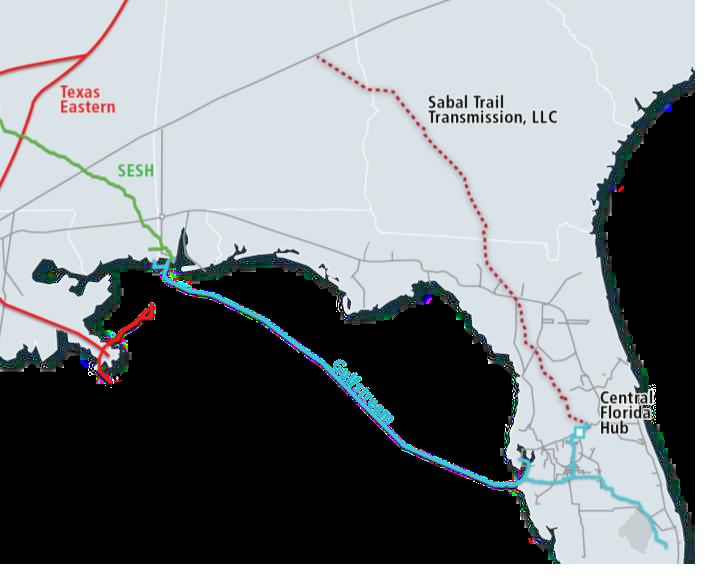September 2013, Vol. 240 No. 9
Features
Spectra Energy To Construct $3 Billion Interstate Pipeline Into Florida

Spectra Energy Corp. announced that Sabal Trail Transmission, LLC, a joint venture of Spectra Energy and NextEra Energy, Inc., has been awarded a 465-mile interstate natural gas pipeline project by Florida Power & Light Company (FPL) to begin service in May 2017.
Sabal Trail will invest about $3 billion to construct the pipeline, which will originate in southwestern Alabama and transport natural gas to Georgia and Florida. It will terminate at a new Central Florida Hub south of Orlando, where it will interconnect with the two existing natural gas pipelines that serve peninsular Florida.
The project, which would be the third major gas pipeline serving Florida, will include 465 miles of interstate natural gas pipeline (55 miles in Alabama, 196 miles in Georgia and 214 miles in Florida), capable of transporting more than 1 Bcf/d to serve local distribution companies, industrial users and power generators in the Southeast.
To connect with FPL’s operations, Florida Southeast Connection will spend about $550 million to build 126 miles of separate pipeline from Sabal Trail’s Central Florida Hub to FPL’s Martin Clean Energy Center in Indiantown. It will initially be capable of transporting 400 MMcf/d from Sabal Trail’s Central Florida Hub to FPL’s Martin Clean Energy Center. The natural gas will be used to generate electricity for FPL’s about 4.6 million customer accounts.
The pipeline will transport gas from several points in the U.S., including West Texas shale formations and wells in the waters of the Gulf of Mexico, according to Spectra.
Permitting is underway for both projects, and construction is expected to begin in 2016 in order for operations to commence in 2017. As interstate natural gas pipelines both are subject to Federal Energy Regulatory Commission (FERC) approval and oversight.
“Natural gas is vital to the reliability and affordability of electricity in our state. Although Florida has essentially no natural gas reserves, many areas of our country have a wealth of supply,” said FPL President Eric Silagy. “This project is not only about FPL and our customers – increasing access to clean, efficient, U.S.-produced natural gas will benefit the entire state.”
FPL’s economic analysis showed that these projects will save FPL customers nearly $600 million compared with the next closest proposal. The utility expects peak electricity demand in state to reach 25,724 mW in 2017, an increase of 20% over five years.
Florida uses more natural gas to generate electricity than any state except Texas, but it has minimal production, no storage capabilities and only two major pipeline systems available to transport natural gas to the peninsula.
With the two existing major gas pipelines nearing full capacity Florida’s economy is projected to require additional electricity – and, consequently, more natural gas – in the near future. FPL, the state’s largest electric utility and largest natural gas user, will be an anchor customer for the new pipelines. The proposed route of the new system will maximize access to all of Florida’s major natural gas users.
“Natural gas, especially when used in combination with solar energy, generates far fewer emissions than coal or oil,” said Eric Draper, executive director of Audubon of Florida. “Audubon provided guidance on the proposed pipeline route, and we commend FPL for working to avoid sensitive habitats.”
The new pipeline system will expand the state’s access to additional sources of natural gas throughout the U.S. This will help reduce the state’s reliance on offshore sources and lessen its vulnerability to fuel supply interruptions that can occur in the Gulf of Mexico region during severe tropical weather.
“Like a highway interchange connects intersecting roads, the new system’s Central Florida Hub will link the state’s major natural gas transportation infrastructure. This will effectively increase our state’s energy security and reliability by introducing important flexibility in the event that the supply of one of the existing pipelines is interrupted,” Silagy said.
In Florida, the projects will create an estimated 8,600 direct and indirect jobs during construction and generate more than $1.1 billion in new tax revenue for local schools and governments over 60 years.
Over the past decade, Florida Power & Light (FPL) has reduced its use of oil by 98% by investing in new, highly efficient power plants that use U.S.-produced natural gas as a fuel to produce electricity. In 2001, FPL used more than 40 MMbbl of oil to power customers; in 2012, the company will use less than 1 MMbbl.
Meanwhile, FPL began operations at a new natural gas plant in Cape Canaveral and expects to add power plants in Rivera Beach and Port Everglades during the next few years. But Duke Energy has pulled the plug on its proposed Levy nuclear reactor project in the state. It would have taken the place of the defunct Crystal River nuclear plant.
“Spectra Energy is extremely pleased to have secured the bid to build and operate this interstate natural gas pipeline as a result of our competitive response to FPL’s request for proposal (RFP). We are excited to work with FPL and NextEra Energy to bring this critically needed third interstate natural gas pipeline into Florida, which will provide safe, clean burning, affordable natural gas to power the state’s homes, businesses and economy,” said Bill Yardley, president, U.S. Transmission and Storage, Spectra Energy Corp.
“Our Sabal Trail development team is committed to engaging with stakeholders throughout the process to ensure the smooth construction of this pipeline which will provide reliable natural gas supply and significant economic benefits, including increased tax revenue and local jobs, to the Southeast region,” added Yardley.
“Successfully securing this project is a testament to our strong history of successful project execution and advances our strategy of maximizing shareholder value by executing more than $25 billion in growth projects through the end of the decade.”





Comments